I did baby led weaning with both of my two when they were little nippers, and I found it a really enjoyable experience with both of them. Seeing their facial expressions as they explore different tastes and textures. The concentration of trying to pick up peas with finger and thumb! Watching a baby eating spaghetti bolognese for the first time is very entertaining. Just be ready with a bath afterwards!
Both of my girls loved mealtimes from the get go. I think this is because we followed such a relaxed, natural approach. It was just another type of playtime for them, where they got to eat!
I think traditional weaning would have really stressed me out. I would have been worrying about how many spoonfuls they were eating and was it more or less than the day/week before. Leftovers would have really annoyed me if I'd gone to the extra effort of preparing purees especially. And I would have been stressed about which foods to introduce and in what order, when to start giving mashed food and lumpy textures and so on.
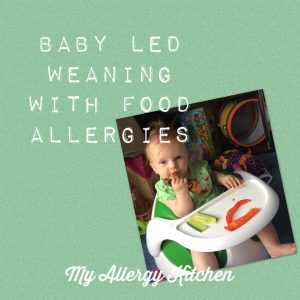
Why Baby Led Weaning (BLW) is Great
The biggest benefit of baby-led weaning is that your baby gets to join in with family meals right from the beginning. Conveniently, there is no need to prepare separate food for your baby. They can share the family meal. Although, if you like extra-hot vindaloo, it might be better to switch to korma for a while!
It's also lovely to include your baby in family mealtimes, rather than spoon-feeding them separately. It's an important social family time so it's great to start this habit from the get go. It also means they are able to watch you and learn about how to use a knife and fork, drink from a cup, and table manners.
Another advantage of baby-led weaning is that it allows babies to go at their own pace. Some may be ready to eat 3 meals a day from 6 months of age, some may still just be grazing by 10 months of age. There are no mealtime battles - just allow them to explore them in their own way and in their own time. You decide what to serve and when, and they decide how much to eat from the choices given. Sometimes 'how much' might be nothing, other times they may devour everything and ask for more. We have continued in the same way as they have grown older, using Ellyn Satter principles.
It's really fun! Babies get to explore all aspects of new foods - taste, texture, colour and smell. For the first few months mealtimes are like multi sensory playtimes. I really enjoyed sharing new foods with both of my two when they were babies and watching them discover new things. It's so important that they get used to a variety of tastes from the get go, as this makes things easier when they get older. It also allows them to develop their fine motor skills and ability to chew and swallow different textures.
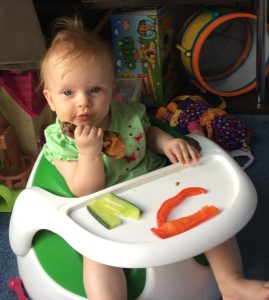
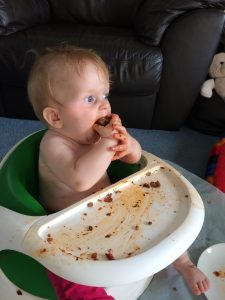
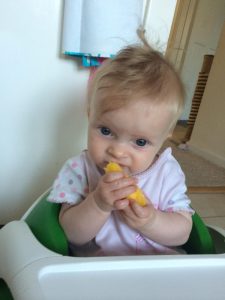
Downsides of Baby Led Weaning
Firstly, mess! A lot of it will end up on the floor, especially to begin with, so be prepared for this. If you have carpeted floors, lay a mat under your baby's high chair to make cleaning up easier. Get a high chair that is easy to take apart and clean. We used a Fisher Price Healthy Care Booster Seat, which fits onto a dining chair. It is smooth with no nooks and crannies so it's easy to wipe clean, and the tray can go in the dishwasher. When weaning babies, there's really no escaping mess! Even with puree feeding, you will be washing up pots and pans and blenders.
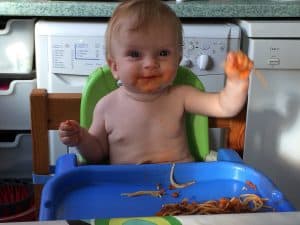
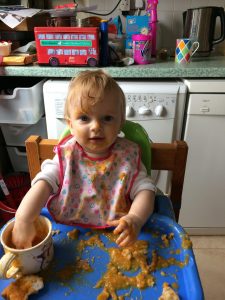
Secondly, you can't tell exactly how much your baby has eaten. However this is a great lesson for the baby in learning to listen to their own body, and for mums in allowing babies to trust their own instincts - if they are hungry, they will eat! They are still getting a lot of nutrition from their milk feeds. Sometimes it is easier to think in terms of what they have eaten over a week as a whole, as their appetites can vary from day to day. You can also get a good idea of how much they are eating from their nappies - as they eat more solids, what comes out will get more solid too!
Adapting Baby Led Weaning for Babies With Allergies
If your baby already has a known food allergy such as CMPA, there is an increased chance that they may be allergic to other foods as well. So that you can watch for any reactions, you should only introduce one new food every 3 days, especially for the most common allergens. These are: milk, wheat, egg, soya, oats, fish, shellfish, peanuts, nuts, sesame, mustard, celery, lupin and sulphites. You don't need to wait to introduce these more allergenic foods. In fact, introducing them after 12 months actually increases the risk of them developing an allergy!
We didn't have this advice at the time and just went in gung-ho, and got in a terrible mess. She started having allergic reactions almost constantly, although we didn't know that's what it was at first. We couldn't identify all of her allergens until 12 months which meant a lot of needless suffering and not much sleep, so please learn from my mistakes!
There are pros and cons to both baby led weaning and traditional weaning. Do what works for you and your family. And most importantly, enjoy it!
Do you have any tips for baby led weaning with food allergies? Leave a comment below!
Weaning Recipes
Check out my favourite dairy-free weaning recipes, as road-tested by my two test subjects victims children!
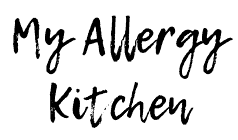

Claire
Instead of putting a bib on my son I just have him wear nothing but a nappy and dunk him in the bath after mealtime! it makes it so much easier because as you know.. baby food stains! I was getting a little worried at one point as there was always a lot of food left on the floor and the highchair so I was fretting that he wasn't getting enough, but as you said if he's filling his nappies then he must be getting enough!
Zoe
Yes it's definitely much easier to clean up in the summer when they can just sit in their nappy while they are eating and go straight in the bath afterwards! There's no need to worry if there's food left over or on the floor - think about what your little one is eating over a week rather than focusing on individual meals. Their appetite can vary a lot, even during the course of a day.